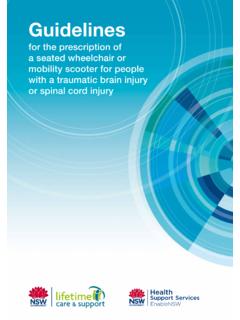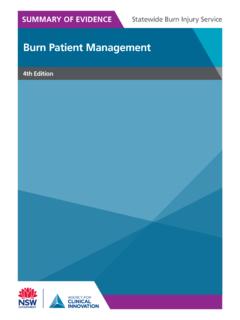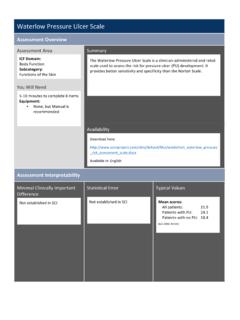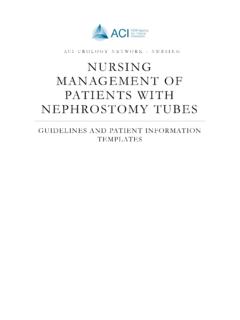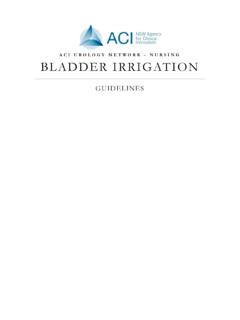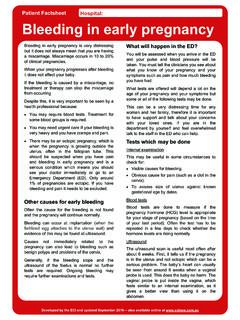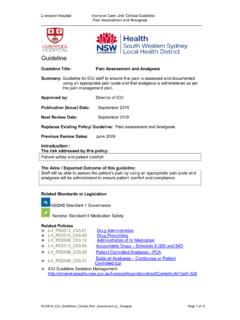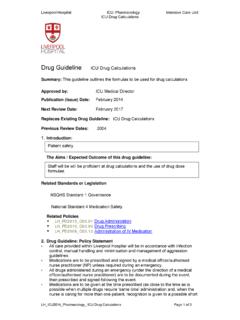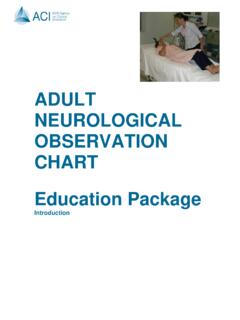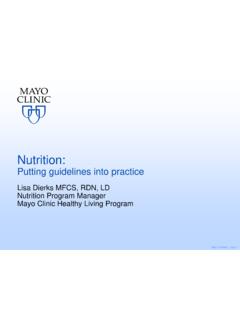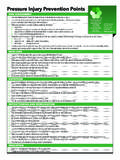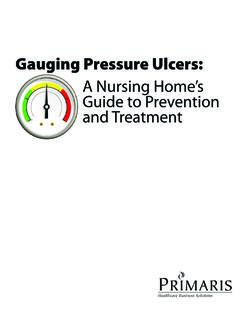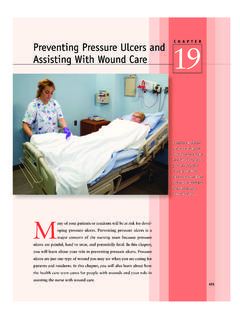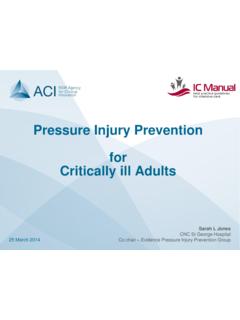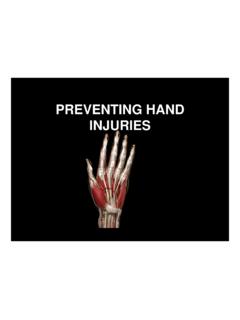Transcription of Pressure Injury Toolkit - Agency for Clinical Innovation
1 The SCI Pressure Injury Toolkit Lyndall Katte, Project Officer John Walsh Centre for Rehabilitation Research, University of Sydney A/Professor James Middleton, SSCIS & JWCRR, The University of Sydney Dr Janet Long, JWCRR, The University of Sydney Elizabeth Dallaway, Project Officer, JWCRR, The University of Sydney Frances Monypenny, Manager SSCIS, NSW Agency for Clinical Innovation MOH Knowledge Translation Grant: Developing a community of practice for knowledge translation and practice improvement in spinal cord Injury and traumatic brain Injury Implementation Science study design: Careful consideration of context and current practice in diverse settings Iteratively defining best practice Mapping of different practice pathways Identifying opportunities to enhance specific processes to improve practice Evaluation includes acceptability, feasibility and compatibility or fit with existing modes of service-delivery 2 PI MOC Implementation Project Model of Care launched April 2014 Online Decision Support Tool SCI Pressure Injury Toolkit informed by CPGs and best practice principles from original MOC consultation and stakeholder dialogue.
2 Toolkit will provide access to triage/referral pathway, risk assessment tools, SCI specific assessment tools and coordinated care plan templates. The resource will be hosted on the ACI website and will also provide links to other helpful online consumer and clinician resources. Aim of the Toolkit : To enable health professionals to undertake comprehensive assessment and management of Pressure injuries in people with a spinal cord Injury . Key messages are to: 1. Think beyond the wound a d o sider the auses a d o tri uti g factors that impact upon wound healing and increase future risk of skin breakdown. best practice principles and evidence informed decision-making into Pressure Injury management for people with spinal cord Injury .
3 Wound healing regularly to monitor progress and to reduce risk of developing complex or chronic wounds that may impact negatively on health, participation and quality of life. NB. Whilst the Toolkit may be useful for adults with other neurological conditions such as Spina Bifida, additional resources (eg: SBART) will be necessary to adequately support Pressure Injury care in these individuals. (NB: further consultation required) 4 Diverse range of Pressure Injury resources now available for SCI and non-SCI populations 5 Spinal Cord Injury Pressure Injury Toolkit - DRAFT 1. Screening Person with SCI presents with a Pressure Injury 2. Assessment Wound Assessment Red Flags Screening Yellow Flags Screening Cause & Contributing Factors 3.
4 Management / Treatment: Wound Cause & Contributing Factors 4. Re-Assessment Tertiary Referral Monitor If wound deteriorating or not responding to treatment tertiary referral to spinal Pressure Injury services may be required Wound Healed Successfully Early tertiary referral is required for Grade III-IV or DTI Pressure injuries or complex co-morbidities Person with SCI and carers encouraged to perform routine twice daily skin inspection. Community nursing to perform Pressure Injury screening during routine monthly catheter change 6 Assessment The Wound Clinical history Physical examination Skin assessment Laboratory tests Risk factor Re-assessment Cause & Contributing Factors Nutritional assessment Continence assessment Cognitive assessment Psychological assessment Social assessment Financial assessment Personal care needs assessment Mobility and activity assessment Position, Posture and equipment assessment Assessment of extrinsic risk factors 7 2.
5 Assessment Wound Assessment Red Flags Screening Yellow Flags Screening Cause & Contributing Factors A comprehensive assessment should include: After SCI, in addition to the above assessment processes, screening for red flags is required during the assessment phase and consideration of yellow flags is also recommended. Wound Assessment LOCATION Helps to identify possible causes Helps to identify positioning to allow healing Remember risk to other areas / bony prominences SIZE Consistent measurement will improve accuracy and assist reassessment: Length Width Depth Depth of undermining STAGE Identify the stage of the Pressure Injury : Stage 1 Stage 2 Stage 3 Stage 4 Suspected DTI Unstagable VALIDATED TOOLS Validated Wound Assessment Tool helps to systematically evaluate and document to improve treatment planning and re-assessment.
6 BWAT PWAT PUSH tool Acetate Trace Photography 8 The wound cannot be treated in isolation [CBPG; Pan Pac] 2. Assessment Wound Assessment Red Flags Screening Yellow Flags Screening Cause & Contributing Factors Location: Posture Sitting The ischial tuberosity, k o as IT s or sitti g o es are at risk due to ed te ded periods using a wheelchair for mobility. The ski o er the IT s aLJ also e s raped from trauma during transfers if adequate clearance is not achieved. Sitting results in Pressure through the is hial tu erosity's IT s or the sitti g o es A Pressure i jurLJ of the IT s has erLJ serious i pli atio s i people ith CI Image credit: CSCM CPG Image credit: Sunrise Medical Image credit: CEC Pressure Injury Project Image credit: Australian Wound Management Association In this position, the heel is also at risk due to increases in Pressure from positioning, inability to move the lower limbs easily to re-distribute Pressure , and reduced or absent sensation.
7 9 If wound is on a sitting surface refer to OT or seating therapist as soon as possible Sliding forward in the wheelchair or sitting reclined in bed > 30 degrees back of bed elevation, additional forces such as shear or friction may be created affecting the sacrum Stage: Suspected Deep Tissue Injury Purple or maroon localised area, discoloured intact skin, or a blood filled blister due to damage to the underlying soft tissue from Pressure and/or shear. The area may be preceded by tissue that is painful, firm, mushy, boggy, warmer or cooler as compared to adjacent tissue. Deep tissue Injury difficult to detect in individuals with darker skin tone.
8 Evolution may include a think blister over a dark wound bed. The PI may further evolve and become covered by thin eschar. Evolution may be rapid exposing additional layers of tissue even with optimal treatment. Spinal Tip! Deep Tissue Injury involves progressive damage from the muscle layer to the dermis and is characteristic of patients with impaired motosensory function (Gefen 2007). Obesity can increase the risk of Deep Tissue Injury after SCI, likely due to increased internal stress combined with muscle atrophy (Elsner and Gefen 2008) and vascular compromise. Consider ultrasound imaging of the tissue overlying the ischial tuberosity (IT) to identify potential deep tissue Injury (CBPG Recommendation Level III) For more details visit: Access the HETI education modules: 10 Image Credit: Reproduced with permission of AWMA.
9 All rights reserved Assessment Red Flags Screening It is important to screen for Red Flags that require urgent Clinical attention. Red flags that may be associated with Pressure injuries after SCI include: Persistent Autonomic Dysreflexia (AD) * -This is a Medical Emergency - refer directly to AD treatment algorithm -Persistent or recurrent AD may indicate a change in wound status Signs of sepsis Also consider potential for rapid deterioration from: Severe malnutrition Presence of multiple Pressure injuries Wound Deterioration Secondary complications of bedrest * AD is a potentially life-threatening condition, which affects individuals with spinal cord Injury (SCI) above the major splanchnic outflow (typically from a lesion at or abovethe T6 neurological level) (Teasall et al 2000) Assessment2.
10 Assessment Wound Assessment Red Flags Screening Yellow Flags Screening Cause & Contributing Factors 11 Potential Red Flags: Complications of Bed Rest Definition: Bed rest is often required for healing of Pressure injuries, particularly those located on a sitting surface. However, bed rest may also contribute to development of complications that need to assessed for on a regular basis during the wound healing period. Secondary complications may include: Deep Venous Thrombosis (DVT) Pulmonary Embolism (PE) Pneumonia Secondary Pressure areas Dehydration / Malnutrition Contractures Clinical Presentation: Hypotension Shortness of breath Localised calf swelling and redness (+/- pain depending on persons level of SCI and sensation) Chest Pain on deep inspiration Productive cough / Difficulty expectorating secretions Assessment: Blood Pressure Respiratory Rate Auscultation Visual inspection and palpation of calf Investigations.

